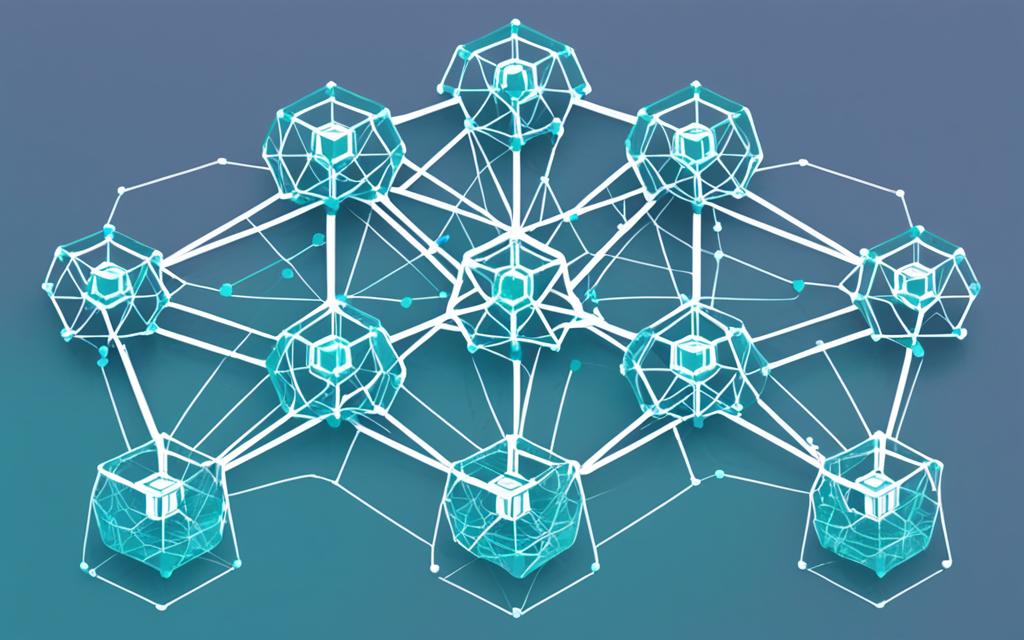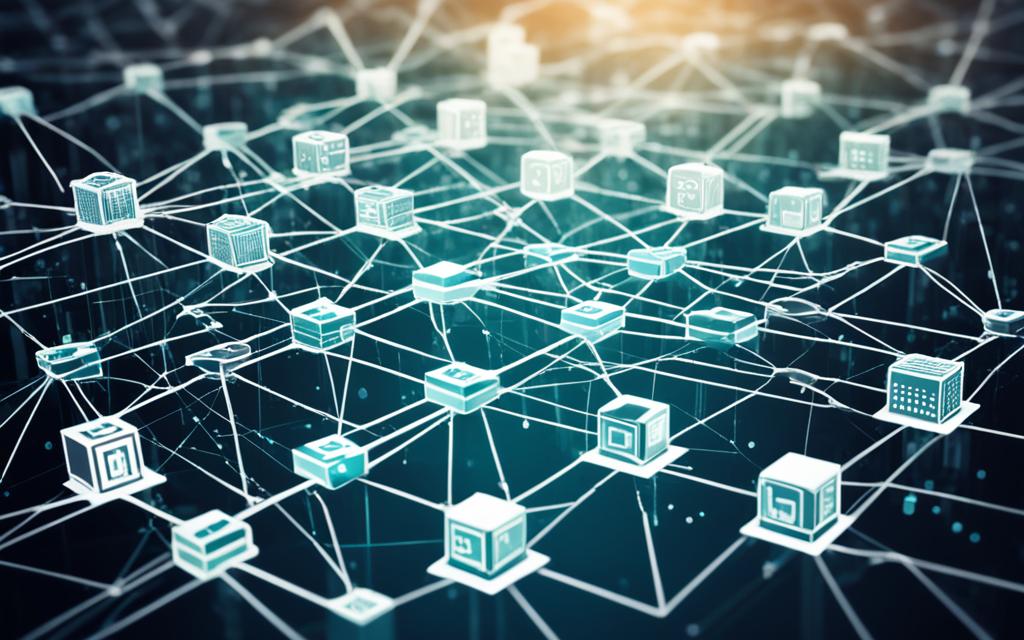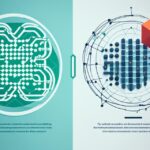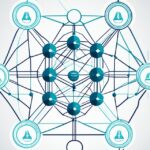Table of Contents
A blockchain is a database shared across a network’s computers. It keeps a secure and decentralised record of transactions. Many people look after a blockchain’s ledger1, including miners, validators, and governance rules.
Key Takeaways:
- Blockchain electronic ledgers are overseen by participants including miners, validators, and governance protocols.
- Blockchain technology ensures secure and decentralized record-keeping of transactions.
- Miners contribute computational power to secure the blockchain network.
- Validators play a crucial role in verifying and validating transactions.
- Governance protocols establish rules and protocols within the blockchain network.
The role of overseeing blockchain technology is becoming more important. Miners help keep the network safe by using their computer power. They solve tough problems to add new blocks to the blockchain.
On the flip side, validators check if transactions follow the rules. They ensure deals are OK and join in a process to agree on their validity.
There are also governance rules that help manage the blockchain. These rules are part of the network’s structure. They keep everything running well and the record in order2.
By having different people look after the ledger, blockchains can be safer and fairer. This stops any one person or group from controlling everything. It makes people trust the system more.
Blockchain technology has changed many fields like banking, healthcare, and trading. It makes operations safer and clearer. Now, we can trace food, make secure deals, and keep medical records safe thanks to blockchain. It’s changing the way we do things and making us more powerful.
What Is a Blockchain?
A blockchain is a new and powerful technology. It has changed many fields. Simply put, it is like a very secure online record book. This record book is shared and kept up to date by many computers at once.
Blockchain technology got its start with Bitcoin and other cryptocurrencies. But its uses go way beyond just handling online money.
It works like this: information is stored on lots of computers, not just one. These computers are part of a worldwide network. They check and update the information together.
The information is kept in a ledger. Think of the ledger as a clear and unchangeable history of all the activities. Transactions are put into groups called blocks. Then, each new block is securely joined to the ones before it. This creates the ‘blockchain’ of linked blocks.
With a clever process called hashing, the blockchain’s contents are locked. This means it’s extremely hard for anyone to sneak in changes. The data stays the way it was, safe and sound. This is what makes blockchain very secure.
What’s neat is that no single person or company is in charge of the blockchain. Everyone who uses the system helps to keep it honest and up to date. This is part of what makes it so trustworthy.
Without middlemen getting in the way, blockchain can speed up how we do business. It also can make things more open and fair. This can lower costs and allow for new, more direct ways of working.
Blockchain’s impact can reach far beyond just how money moves. It’s showing up in areas like tracking products, healthcare, voting, buying homes, and storing files online. This wide use shows how adaptable and powerful blockchain truly is3.
| Blockchain Attributes | Description |
|---|---|
| Data Immutability | The data recorded on the blockchain is permanent and cannot be altered, ensuring the truth of transactions and details. |
| Decentralization | Blockchain works across many computers, not just one, which removes the need for a single boss and makes it stronger and safer. |
| Transparency | Every transaction on the blockchain can be seen by everyone involved, encouraging trust and clear responsibility. |
| Security | The way blockchain protects data is very safe and private from those who shouldn’t see it, stopping any cheating or fraud. |
| Efficiency | It’s fast to process actions through blockchain, much quicker than the old ways. |
How Does a Blockchain Work?
A blockchain is a high-tech digital database that works over a wide network. It’s built to collect and hold info about transactions in blocks. Every block keeps secret info and a special code linking it to the last block, forming a chain of data.
Using a blockchain starts with people making transactions. These wait in a pool until miners insert them into a block. Miners do this by solving tough puzzles, ensuring everything is correct.
When a block is full and solved by a miner, it’s closed. This marks the transactions as final and puts them officially on the blockchain record.
In the world of cryptocurrencies, like Bitcoin, mining does two things. It checks and lets transactions go through, and it makes new coins for the miners. But, blockchains are more than just for cryptocurrencies; they’re used in many industries.
With cryptocurrencies growing, blockchain’s use is expanding too. By September 2023, over 9,000 of these digital currencies were out there. This shows how big blockchain is for money, goods moving, and making things4.
One cool use of blockchain is for smart contracts. These can work on their own, without anyone in the middle. Ethereum is a top choice for these mini-contracts in money, supplies, and homes. It changes how we do deals, making them quicker and clearer4.
Blockchain works without one boss, thanks to many connected computers working together. Each part of this big web helps keep things safe, stopping any cheats and making sure all agree on the right info. This stops crashes and makes everything more trustworthy4.
Blockchains use special maths (hash algorithms) to keep data safe and untouchable. This makes blockchain a top pick for jobs needing very safe data, like buying and selling goods and services4.
One cool thing about blockchains is how open they are. Every deal you make is clear to everyone on the network. This sharing makes trust, helps keep everyone honest, and catches errors quickly. It’s key to good money deals, moving goods, and lots more4.
Blockchain is all about everyone agreeing on what’s true. When it’s time to add a block with new info, most of those connected computers must cheer for the same random number. This fair voting makes sure the system keeps running well and everyone can trust it4.
In short, blockchain is a smart, safe, and very public way to record deals and run the digital world. Its clever parts work together to make sure the system is sound, secure, and open for everyone4.
Blockchain Decentralization
Blockchain technology stands out for being decentralized. This means it’s not controlled by one single entity. Instead, data is spread across many network nodes.
This set-up helps prevent anyone from changing the data. Because no single node can do it. And, each transaction gets checked and recorded by lots of nodes. This makes the record open and unchanging.
Decentralization in blockchain tackles issues with big, centralised softwares. These systems can often struggle to cope with more users without direct help. Also, they might have weak spots that slow everything down.
Centralised systems also risk user data privacy and safety. User information is kept on certain servers, which hackers could target. Plus, those in charge of the servers might misuse or peek at the data5.
Blockchain, however, decentralises things, making a fairer way for messages and payments5. In blockchain, everyone has an even say. No one entity gets more power. This fair approach appeals to many outside finance and cryptocurrency too5.
Decentralization is key in Web 3.0, giving users more control over their data5. It lets people manage who sees what in their online life. This cuts down on the problems with big, centralised websites.
People are working to make the internet less central and more fair. This involves many ideas to spread the power around and boost what users can do5. The aim is for the web to be a better space for everyone.
The European Commission is putting a lot of money into blockchain to help it grow6. They’re big supporters of its potential. Bodies like the European Blockchain Partnership and INATBA are helping to make blockchain more reliable6.
How much the EU is supporting blockchain shows at events bringing experts together6. These talks help set common rules. This makes blockchain work better for everyone involved6.
As blockchain changes how we work and use the internet, a decentralised future looks clear. Going down this path can give power back to the people over their own information. It paves the way for a stronger, fairer online world.

| Statistical Data | Sources |
|---|---|
| In 2019, Microsoft Azure reported running out of virtual machines for its customers in the East U.S. | Source 1 |
| In March 2020, Azure faced a shortage in data center capacity due to high demand as a result of the Covid-19 pandemic. | Source 1 |
| The European Commission has invested more than €80 million in projects supporting blockchain technology across technical and societal areas. | Source 2 |
| Up to €300 million is expected to be further invested in blockchain technology until the end of the EU funding programme Horizon 2020. | Source 2 |
| The paper mentions a taxonomical classification of decentralized systems developed by Glaser and Bezzenberger in 2015, which classifies cryptographic tokens, cryptocurrencies, decentralized organizations, and decentralized applications. | Source 3 |
| The historical understanding of decentralization is traced back to the mid-1800s, with Tocqueville differentiating between centralized governance and decentralization, where the latter is seen as empowering the individual. | Source 3 |
Blockchain Transparency
Blockchain technology has changed the game in transparency. It brings a new era of accountability to many industries. Its decentralized design lets all transactions on the network be openly viewed and checked by anyone. This7 makes trust stronger and allows everyone involved to see the full history of transactions.
Blockchain explorers are a big part of making everything transparent. They help people watch assets move in real-time and see details of each transaction. This way, it is really easy to track everything8.
Blockchain is not just for money matters. It’s being used by governments and groups for things like tracking land, voting, and managing supply chains. These uses increase how much we can trust what’s being done and recorded.
One big plus of blockchain is fighting fraud and corruption. When governments use blockchain for their dealings, it’s harder to change or fake the data. So, people have more trust in their government8.
Also, putting blockchain in E-Governance has made things work a lot better. It cuts down the time and mistakes in old, slow processes by automating them. This saves a lot of time for important work. The progress made is a real sign of how powerful blockchain is8.
Blockchain’s clear view is key for making choices based on solid facts. With a ledger everyone can see, decision-makers get to use facts that are reliable. This9 drops guesswork and lets companies/organisations make smart moves with the latest real data.
To wrap up, blockchain is changing how honest and clear we are in many sectors. It reaches from handling money to how governments run things, letting people keep an eye on movements and preventing fraud, all while working more efficiently. Its open way of working is making big changes and helping build firm trust.
Is Blockchain Secure?
Blockchain is well-known for its strong security. It uses advanced methods to protect against fraud. These methods include immutability and special cryptography.
Once something is on the blockchain, changing it is almost impossible. This makes the data safe from fraud or changes.
Additionally, blockchain uses cryptography for extra protection. Every deal is signed electronically with a secret key. This means only the right person can make changes or approve deals.
But, blockchain can still have weak points. These might come from mistakes in the code, which hackers could use. People who design and build blockchain need to watch out for these risks.
Experts have found many risks by watching how blockchains can be attacked10. These risks include Smart Contract Injection and other threats that can leak info. Solving these weaknesses is key to making sure blockchains are safe.
Even with risks, top blockchains like Bitcoin and Ethereum are very secure. This is because they are big, have lots of users, and are spread out. So, they are harder to attack as a whole.
| Security Concerns | Description |
|---|---|
| Energy Consumption | Tasks in blockchain, such as Bitcoin’s way of working, use lots of power. This raises worries about the environment and costs11. |
| Scalability Issues | At busy times, blockchain can be slow. This is because of its size and how it works11. |
| Regulation Concerns | Some rules and laws slow down how blockchain can be used. Governments want to update laws to fit blockchain better11. |
| Banking | Blockchain helps banks be faster and safer. It cuts costs for international payments and keeps data very secure11. |
| Smart Contracts | Smart contracts make deals faster and check for mistakes. They mean we need fewer middlemen, which can make things simpler and cheaper11. |
| Cybersecurity | Blockchain’s design makes it very hard to tamper with. This makes it a strong tool against cybercrime11. |
| Healthcare | In healthcare, blockchain keeps patient info safe. It helps speed up things like making insurance claims and makes sharing info safer between doctors and patients11. |
| Logistics | In shipping, blockchain tracks items and where they are. This can help stop cyber-attacks and make things work better11. |
| NFTs | Blockchain is key for NFTs, making sure they’re real and owned correctly. It uses special tech to track who owns them11. |
Bitcoin vs. Blockchain
Bitcoin and blockchain are deeply connected but have different roles. Bitcoin is a big use of blockchain technology. It’s important to know they are not the same thing. They both help change finance and technology.
The Rise of Bitcoin
In 2009, someone named Satoshi Nakamoto launched Bitcoin. It was the first digital currency that works without a central authority12. This means no government controls it. People can send money directly to each other, thanks to Bitcoin. This system is secure because of a digital ledger called blockchain13.
The Power of Blockchain
Blockchain serves as the backbone for Bitcoin and other digital currencies14. It’s a digital ledger that’s open, secure, and not controlled by anyone14. This ledger can be used for more than just money. It’s being tested in banking, healthcare, and voting14. This can change how these industries work. It could make things like tracking goods, managing health records, and confirming identities more secure.
Blockchain beyond Bitcoin
With blockchain, we don’t need to rely on a central party for trust, which can make things faster and cheaper, particularly in finance13. It can make global payments, trading, and lending quicker13. It also reduces the chance of errors in transactions and the risk of fraud13.
Blockchain also makes sure transaction data is high-quality13. It can use smart contracts to verify transactions in a way that’s hard to cheat13. These smart contracts can help with things like checking on shipments and making sure financial deals are clear and honest13.
The Future of Bitcoin and Blockchain
To sum up, Bitcoin is just one of many uses for blockchain. This technology could change how many fields work. It could make doing business more efficient and trustworthy. Knowing the difference between Bitcoin and blockchain is key to understanding their full promise.
The Decentralized Nature of Blockchain
Blockchain is famous for its decentralisation. This makes it very different from centralised databases. In a blockchain network, no single entity controls everything. This ensures it is transparent and secure for everyone involved.
The system depends on miners and validators. They are essential in keeping the network trustworthy. They do this by checking and approving transactions. This ensures only correct and valid data gets added to the blockchain.
Decentralisation brings many perks to blockchain networks. It helps spread resources better. This leads to improved performance and more dependable services. Also, decentralisation boosts security by removing vulnerable single points.
Security is top priority in decentralised blockchains. The strict validation rules can slow things down. But, this makes the network safer as it grows.
Companies from many fields see the value in decentralised blockchains. They are using it for quick global aid, secure digital identities, and more. For instance, Contura Energy in the US is using blockchain for better trade payments. This makes things more efficient, cheaper, and transparent15.
Blockchain’s level of decentralisation varies. It depends on many things like how mature it is and how people are encouraged to take part. This affects applications and organisations that work on a decentralised premise.
By being decentralised, blockchain lets people work together in a trusted way. Industries like finance, supply chain, and healthcare benefit. It also sparks new ideas in managing intellectual property and government16.
| Advantages of Decentralized Blockchain |
|---|
| Optimized distribution of resources |
| Enhanced security and lower likelihood of failures |
| Increased consistency in service delivery |
| Trustless environment for value exchange |
Governance Protocols in Blockchain
Blockchain networks need strong governance protocols. These ensure things run smoothly and help make decisions. Governance in the crypto world decides how networks evolve, solve disputes, and choose leaders17.
Governance in blockchain allows users to have a say and make decisions together. Projects use special tokens to give voting power to the community. These are especially useful in DAOs, which are organizations that run without a central authority1718. The use of these tokens is growing, giving more people a voice in crypto projects18.
There are two kinds of blockchain governance. On-chain governance lets the blockchain itself decide on changes. This usually involves miners, developers, and those with voting rights. In Tezos, for instance, token holders can pass their vote to others to make network choices17.
Off-chain governance happens in other places, like social media and forums. Here, discussions and decisions take place. It involves developers, miners, businesses, and users17.
Looking at how often each governance method is used can tell us what blockchain governance styles are most popular17.
The Importance of Governance Tokens
Governance tokens have a big role in creating and managing blockchain communities. They allow communities to lead and shape the projects’ futures. This has led to the rise of DAOs18.
Projects like Yearn.finance have fully handed over control to the community through their tokens18. Others use these tokens to elect council members, like in Polkadot. This lets token holders have a real say in key decisions18.
Governance tokens also act as rewards in the crypto world. In ENS, for example, early supporters got these tokens as a reward, which encourages active participation18.
They also help organize communities in virtual spaces like Decentraland. Here, holders of these tokens can vote on important matters, literally shaping the digital world18.
Blockchain Governance Frameworks and Compliance
Blockchain governance frameworks are key for good governance and to ensure everyone is playing by the rules. Comparing different frameworks can show us what works best19.
Several principles are important for blockchain governance, like being fair, ensuring people follow the rules, and looking out for the ecosystem. These principles guide how governance should work in the blockchain world19.
Because blockchain is so different, we can’t just copy existing governance rules. New, blockchain-specific frameworks are needed to keep things in order and fair19.
| Blockchain Platform | Case Study |
|---|---|
| Bitcoin | Experienced a split after a lengthy debate over block size from August 2015 to January 201619. |
| Ethereum | Conducted a hard fork due to vulnerabilities in smart contracts, leading to over 60 million dollars in stolen tokens19. |
| Dash | – |
| Tezos | Individuals holding governance tokens can delegate voting rights to other nodes for decision-making on network changes17. |
| Hyperledger Fabric | – |
Good governance through protocols, tokens, and frameworks is crucial for blockchain success. It engages the community, promotes democratic decisions, and keeps the blockchain world honest171819.
Role of Blockchain Codes
Blockchain codes are key for better safety, more intricate transactions, and orderly rules in blockchain systems. They are especially needed as blockchain technology grows. Codes, like those from VGO, add extra safety. This makes blockchain networks even stronger.
“Blockchain codes add an extra layer of security and facilitate more complex transactions on the blockchain.”20
Security gets a boost thanks to blockchain codes. They use tough algorithms to keep data safe. This stops hackers and ensures only the right people can access data. Cyber threats find it hard to break in.
Thanks to blockchain codes, tough deals can be done without a hitch. They can run smart contracts automatically. This gets rid of the middlemen and makes things smoother.
These codes also help make sure everyone plays by the rules on the blockchain. They help set agreement rules. This keeps the network fair and makes people trust each other.
“Blockchain codes contribute to the overall health and robustness of the network, ensuring that the blockchain operates efficiently and securely.”20
Blockchain codes do a lot more than keep things safe and fair. They’re used in many ways, like managing supply chains or checking on payments. With certain blockchains, only those allowed can join, keeping things confidential and secure.
But, watch out for scams in the blockchain world. Some bad actors try to trick people with fake digital coins. It’s key to know the risks and pick strong codes for a solid setup.
“Blockchain codes contribute to establishing consensus mechanisms and enable secure interactions within permissioned blockchains.”20
Good coding is a must to stay safe from threats. Coding needs lots of checks and updates to stay strong. Businesses that take coding seriously get more safety. They can do bigger, more honest deals. This opens new doors in business.
Blockchain codes can change how business is done. They spark new ideas and pave the way for a safe, clear, and fast blockchain world.
Ensuring Security and Governance with Blockchain Codes
Blockchain uses codes to keep decentralized networks safe and fair. These codes are important for keeping the whole system secure. They make sure that your data is safe and that no one can mess with it. This helps everyone trust the digital world more.
One cool thing about blockchain is it’s not controlled by one person21. This makes things safer because no one can mess up everything. The special codes use maths and secret writing to block out bad people. This keeps all your transactions safe.
Another cool part is that once something is written down on the blockchain, it can’t be changed21. This makes it a very safe place for things like money, health records, and tracking items. It means you can trust the information completely.
Blockchain also makes things fairer and clearer22. The codes let everyone see and check the records. This builds trust and makes cheating harder. Automatic contracts also help make rules and checks happen without needing people to look over everything22.
With blockchain, doing official work can be much faster and less wrong21. This makes running things smoother. Estonia uses blockchain to make its government work better. It shows how well blockchain can be used for good.
Dubai is aiming to be a leader in using blockchain in its government soon21. It wants its government to be safer and work better. This is a big step in using blockchain to change how governments work everywhere.
To really use blockchain well, people need to learn about it21. Governments should teach their workers about blockchain so they can use it well. It’s also important to tell everyone how blockchain can make government better. This way, everyone can trust and use blockchain the right way21.
Blockchain codes are getting more and more important for keeping things safe and fair. They help add more layers of safety and make working online with others easier. By using these codes, we can make our digital future better and safer for everyone.
Conclusion
Looking at blockchain, we see how many help keep it honest. Miners, validators, and rules work together to check and keep the records right. This makes blockchain a trusted helper for many businesses. With strong rules from VGO, its safety and reliability get a big boost23.
Blockchain changes how things work in many fields. In money and banking, it makes deals and moving money between countries quicker and cheaper23. For tracking products in the supply chain, it offers more clearness, traceability, and cuts down on fraud and mistakes23. It even keeps patient details safe in health care, improves tests, and ensures better control of medicine chains23.
DLT helps in voting too, by making it easier to see and check votes23. Its uses spread across various sectors, like finance, banking, supply chains, health care, and more, proving its great power and advantages23.
Describing it as a world-changing force, blockchain is set to alter global trading, like how shipping containers once did24. It’s a key step in accounting, boosting its dependability even further24. Experts view blockchain as a key rule-builder, affecting both economy and society broadly24. It basically runs the show for global trading, just as shipping containers did the heavy lifting24.
To wrap up, blockchain works well thanks to everyone looking after it. The addition of codes improves how safe and reliable it is. As it grows, the change in industries and the world will become clearer and bigger2324.
FAQ
Who oversees blockchain electronic ledgers?
Many groups work together to watch over blockchain ledgers. Miners, validators, and special codes all help. These include codes from VGO. They make sure the blockchain is open, safe, and trusted for its different uses.
What is a blockchain?
A blockchain is like a digital diary shared by many computers. It’s famous for being secure and not controlled by just one group. This means no need for trust in a central organisation. Anyone can see the history of transactions recorded on a blockchain.
How does a blockchain work?
All transactions are first put together and stored in blocks. Each block has secret data and a special code linking it to the previous one. When people want to buy or sell something (transactions), they are put together in a memory pool. Then miners validate these transactions and add them to a block. Once a block is full, it’s sealed, and the transaction is complete.
What is blockchain decentralization?
Blockchain is spread across many computers, not just one. This setup stops any single computer from changing the data. Everyone can check how things move around (assets) on the blockchain. This way, it’s open and secure for all to see.
How does blockchain ensure transparency?
Blockchain is clear because everyone can see the records. Tools like blockchain explorers let people watch the movement of items (assets) in real-time. This helps find lost or stolen things, as the blockchain shows where the items went.
Is blockchain secure?
Yes, blockchain is very secure because it can’t be changed once a block is added. It uses strong hidden codes and a chain link system that stops fraud. However, there could be weaknesses in the code that hackers might use to break in.
What is the difference between Bitcoin and blockchain?
Bitcoin is one type of digital money that works on a blockchain. The blockchain itself serves more purposes than just money. It can store many types of data clearly and securely. Bitcoin made blockchain famous in 2009.
How does blockchain ensure decentralization?
In blockchain, no one group has full control. Miners and validators keep the system fair by checking and confirming transactions. They follow certain rules so that everyone can trust the blockchain. This democratic setup is very different from traditional databases.
What are governance protocols in blockchain?
Governance protocols in blockchains set up rules for how the network should be run. They keep everything working well and fairly. A group of people helps with decisions that impact the network.
What is the role of blockchain codes?
Codes from VGO help increase the safety and trust in blockchains. They add more layers of security and allow for clever transactions. This makes the whole network strong and reliable.
How do blockchain codes ensure security and governance?
Special codes are key to making blockchains safe and fair. They bring extra security, handle complex transactions, and aid in running the system. This keeps the blockchain sound and true to its principles.
What is the overall responsibility of overseeing blockchain electronic ledgers?
Looking after blockchain ledgers is a team effort with miners, validators, and rules. With help from VGO codes, it’s more secure and trustworthy. These methods keep the blockchain safe for different uses.
Source Links
- https://www.investopedia.com/terms/b/blockchain.asp – Blockchain Facts: What Is It, How It Works, and How It Can Be Used
- https://hbr.org/2017/04/who-controls-the-blockchain – Who Controls the Blockchain?
- https://www.geeksforgeeks.org/blockchain-and-distributed-ledger-technology-dlt/ – Blockchain and Distributed Ledger Technology (DLT) – GeeksforGeeks
- https://www.techtarget.com/searchcio/definition/blockchain – What is Blockchain? Definition, Examples and How it Works | TechTarget
- https://link.springer.com/article/10.1007/s10586-021-03301-8 – Blockchain for decentralization of internet: prospects, trends, and challenges – Cluster Computing
- https://joinup.ec.europa.eu/collection/rolling-plan-ict-standardisation/blockchain-and-distributed-ledger-technologies-0 – BLOCKCHAIN AND DISTRIBUTED LEDGER TECHNOLOGIES
- https://en.wikipedia.org/wiki/Blockchain – Blockchain
- https://medium.com/@syedhasnaatabbas/blockchain-in-e-governance-enhancing-transparency-in-public-administration-49bfa330b5ff – Blockchain in E-Governance: Enhancing Transparency in Public Administration
- https://www.linkedin.com/pulse/role-blockchain-data-products-ensuring-transparency-artasanchez – The Role of Blockchain in Data Products: Ensuring Transparency and Trust
- https://www.cablelabs.com/blog/security-blockchains-distributed-ledgers – Security for Blockchains and Distributed Ledgers
- https://www.builtin.com/blockchain – Blockchain: What It Is, How It Works, Why It Matters
- https://www.weforum.org/agenda/2017/07/blockchain-the-ledger-that-will-record-everything-of-value/ – Blockchain: Blockchain: the ledger that will record everything of value to humankind
- https://www.htcinc.com/latest-news/five-ways-blockchain-technology-is-reinventing-financial-services/ – Five Ways Blockchain Technology is Reinventing Financial Services – htcinc
- https://www.businessinsider.com/personal-finance/what-is-blockchain – What is a blockchain? A digital database used to store data for crypto transactions and other assets
- https://aws.amazon.com/blockchain/decentralization-in-blockchain/ – What is Decentralization? – Decentralization in Blockchain Explained – AWS
- https://medium.com/paradigm-research/chain-of-thought-exploring-blockchain-through-the-lens-of-philosophy-5c81198312bd – Chain of thought: Exploring blockchain through the lens of philosophy
- https://www.ledger.com/academy/glossary/governance – Governance Meaning | Ledger
- https://www.ledger.com/academy/what-is-a-governance-token-and-why-does-it-matter – What Is a Governance Token? | Ledger
- https://arxiv.org/pdf/2110.13374 – PDF
- https://shardeum.org/blog/what-is-blockchain-security/ – Blockchain Security – Types, Importance and Its Testing Tools
- https://www.medium.com/@syedhasnaatabbas/blockchain-in-e-governance-enhancing-transparency-in-public-administration-49bfa330b5ff – Blockchain in E-Governance: Enhancing Transparency in Public Administration
- https://www.dev.to/ovaisnaseem/blockchain-technology-and-data-governance-enhancing-security-and-trust-ofb – Blockchain Technology and Data Governance: Enhancing Security and Trust
- https://blog.cfte.education/distributed-ledger-in-blockchain/ – Distributed Ledger in Blockchain: How it Works?
- https://digitalcommons.law.uw.edu/cgi/viewcontent.cgi?article=5129&context=wlr – The Law of Blockchain








